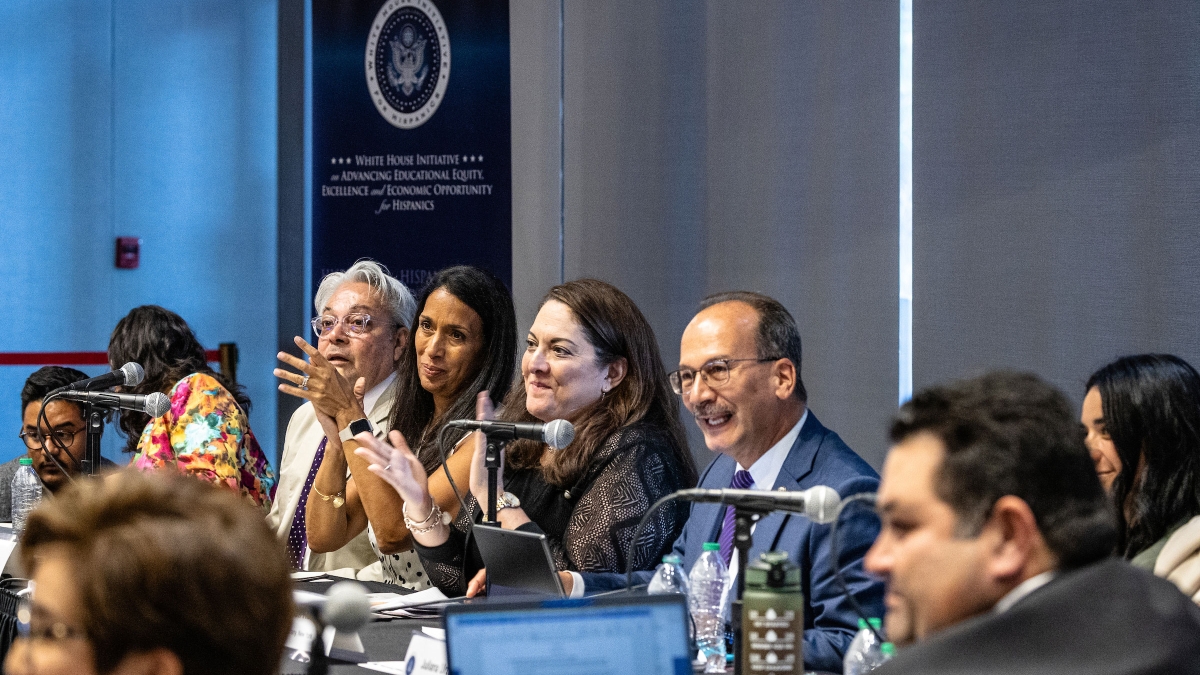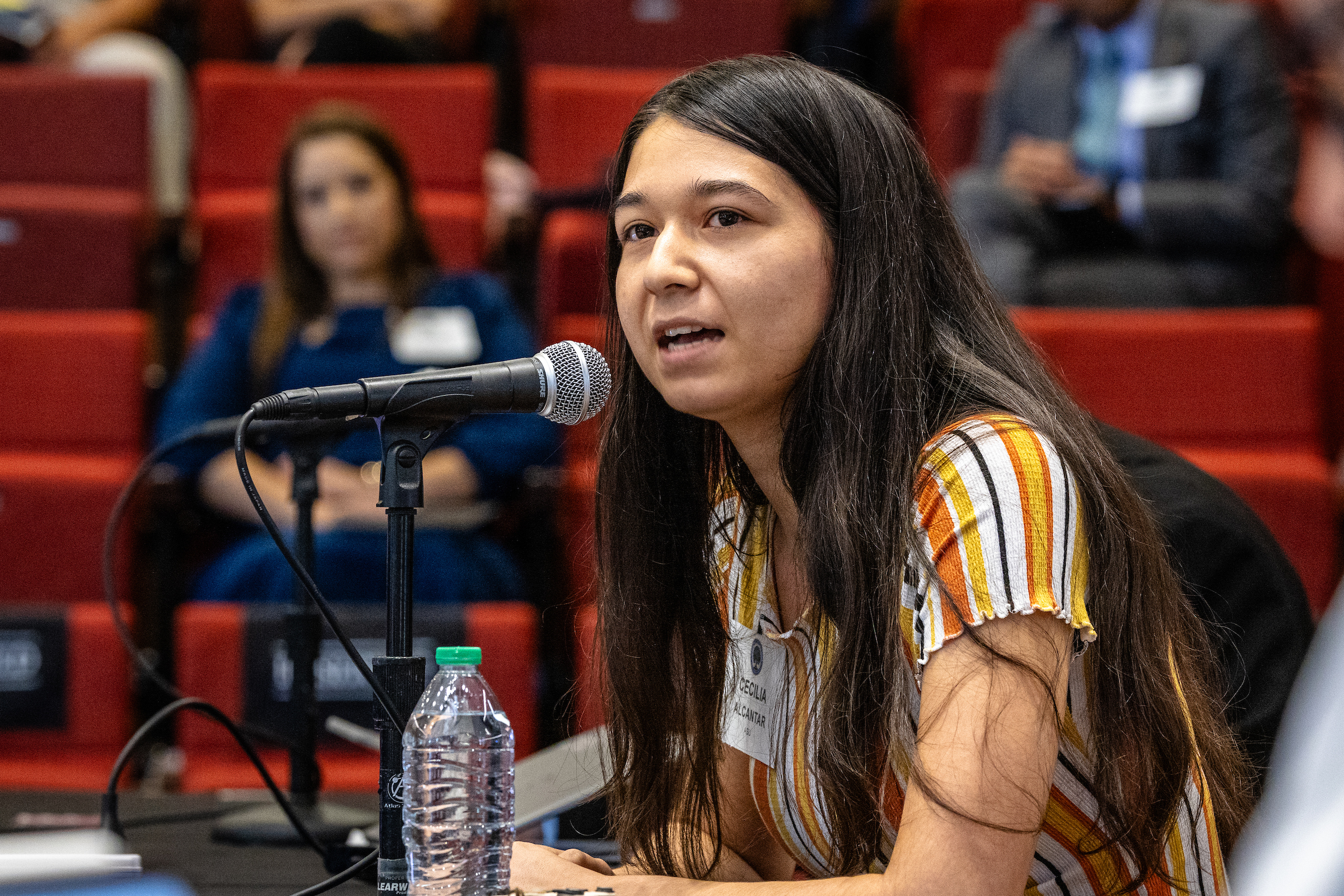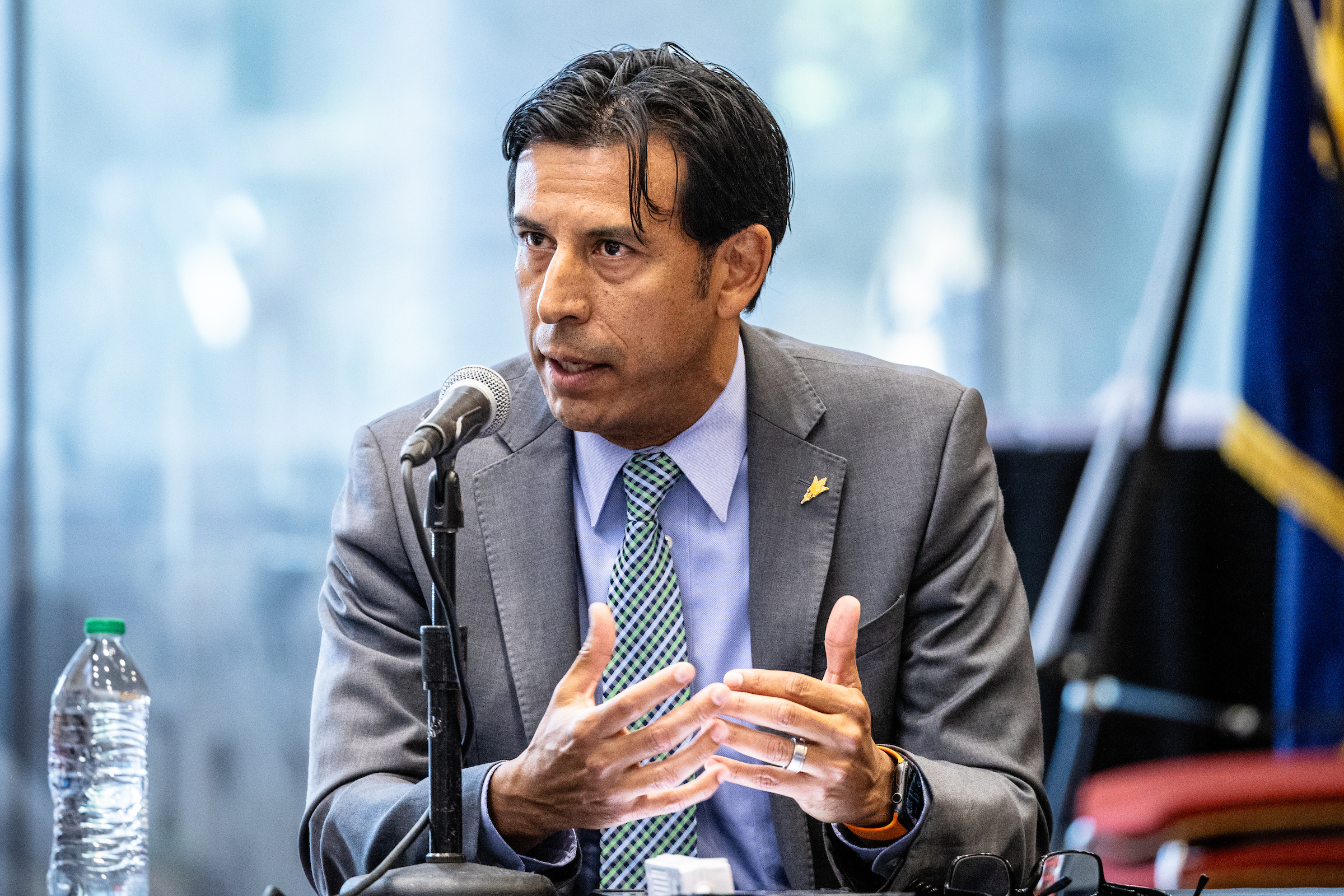Federal commission meets at ASU to discuss equitable outcomes for Hispanic students

A federal advisory commission on education equity for Hispanics met at Arizona State University on Tuesday and voted on four priorities to send to President Biden for consideration.
The President’s Advisory Commission on Advancing Educational Equity, Excellence and Economic Opportunity for Hispanics gathered at ASU’s Downtown Phoenix campus to hear from university, local, state and federal leaders.
Last year, ASU was designated as a Hispanic-Serving Institution by the U.S. Department of Education, and the President’s Advisory Commission’s meeting was held during Hispanic-Serving Institutions Week.
U.S. Secretary of Education Miguel Cardona addressed the meeting via video, saying: “HSIs serve more than two-thirds of our Latino students nationwide.
“They provide inclusive campus communities for everyone involved, including immigrants, Dreamers and first-generation college students.
“We know we must do more to put college within reach of Latino families and families.”
Vanessa Ruiz, deputy vice president for education outreach at ASU, told the commission that the university was the appropriate place for them to meet.
“The commitment we have at ASU to comprehensively support our Latino students and families, and our faculty and staff, is truly a testament to our success in enrolling over 15,000 first-year, undergraduate Latino students last year, a record for us,” she said.
“Many of us are here today because of what our university charter compels us to do, and that is to open the door of opportunity to those we serve. And we do so with a full continuum, beginning with K–12 programming and initiatives across our state and embedding a college-going culture in our high schools, right through the admission process into the university, where students come in and find that they have a community of support here.”
Vanessa Ruiz, ASU's deputy vice president for educational outreach, delivers welcoming remarks at the President’s Advisory Commission on Advancing Educational Equity, Excellence and Economic Opportunity for Hispanics meeting, held Sept. 12 at ASU's Downtown Phoenix campus. Photo by Charlie Leight/ASU News
The four recommendations the commissioners voted to send to Biden and Cardona for consideration are:
• Elevate and expand the Raise the Bar: Lead the World initiative launched by Cardona, which focuses on improving K–12 education, eliminating the teacher shortage, investing in student mental health, ensuring a pathway to college and career, and promoting multilingualism.
• Support community colleges, which are experiencing declines in enrollment, by increasing financial aid, increasing graduation rates, improving transfer to four-year institutions and promoting dual enrollment.
• Improve career pathways, particularly in areas of critical need, such as teaching, health care, cybersecurity and artificial intelligence, where Hispanics are underrepresented.
• Increase the number of Hispanics in leadership positions in higher education by raising the number of Hispanics in post-graduate degree programs and leadership-development programs, and track the data.
During the daylong event at the Beus Center for Law and Society, the commissioners heard several presentations on the state of education and economic opportunity for Hispanics.
Highlights include:
A pivotal moment for equity
The government is making enormous investments with initiatives such as the CHIPS and Science Act, the Inflation Reduction Act and the Bipartisan Infrastructure Deal, which will create tens of thousands of jobs that need to filled. At the same time, political divisiveness and inequity are flourishing.
• Tom Perez, senior advisor and assistant to the U.S. president: “We’ve never had this level of investment, in CHIPS, in broadband, at one time, and that’s why the unemployment rate for Latinos is as low as it is. But we have way too many disproportions in health status, educational opportunities and home ownership. … My parents taught me, and the evidence teaches us, that education is the great equalizer.”
• Neera Tanden, Domestic Policy Council director in the White House: Tanden said the administration is working to ensure that Latino workers and businesses benefit from these federal investments. “We are seeing successes with some of the plants coming online, that the workforces are more diverse than we’ve seen,” she said.
Helping Latino students thrive
Beyond the critical issue of financial aid, post-secondary institutions need to help Latino students feel welcome and succeed on campus.
• Amalia Pallares, vice chancellor for diversity, equity and inclusion at the University of Chicago and the incoming vice president for inclusive excellence at ASU: “When you come from a community that is very collective, it’s very hard to enter academia because academia is very individualized. While one-on-one mentorship is great, it’s important to create communities.” The University of Chicago created a summer institute for Latino second-year grad students in which they received support and participated in a research project. “By the time they were done, they knew a community of people who were doing work they were excited about and they didn’t feel isolated any more. When you create that community, they generate their own leadership and agency.”
Thunderbird School of Global Management graduate student Cecilia Alcantar-Chávez speaks during the advisory commission meeting. Photo by Charlie Leight/ASU News
• Cecilia Alcantar-Chavez, a Master of Global Management student at the Thunderbird School of Global Management at ASU and former student body president of the Polytechnic campus: Alcantar-Chavez gave several examples of Latino students who faced obstacles on the path to a college degree, including health issues and the need to reject prestigious but unpaid internships. “I was in my junior year when I came into class and the professor was talking about a study abroad trip. I’m scrolling through and wondering what the price is and I see it’s $17,000. I closed the tab and thought, ‘I can’t do that.’” A few months later, she learned that another student won a scholarship for the trip. “I messed up. I shouldn’t have closed off that opportunity. … We should be giving students the resources to make the best decisions for themselves.”
Experiential learning is key
Latino students and families need to see themselves in college and in 21st century careers.
• Octavio Heredia, director of global development, global outreach and extended education for the Ira A. Fulton Schools of Engineering at ASU: Heredia cited several university initiatives, including the $270 million Materials-to-Fab prototyping facility with Applied Materials Inc. that will give ASU students hands-on experience with specialized equipment and the AZNEXT accelerator, focused on apprenticeships and experiential learning. “We have a Rio Salado College partnership where students in the manufacturing and nanotechnology certificate program come to ASU to access a clean-room facility and equipment that makes the program richer by giving them hands-on, applied learning.” He also discussed ASU’s Hispanic Mother-Daughter Program. “That’s really about providing the tools and resources to families with first-generation students and low-income students to have the knowledge and skills to see themselves as successful in a higher education environment.”
Octavio Heredia, Ira A. Fulton Schools of Engineering director of global outreach and extended education, speaks during the advisory commission meeting. Photo by Charlie Leight/ASU News
• Leah Palmer, executive director of the Arizona Advanced Manufacturing Institute at the Maricopa Community Colleges: Palmer shared how the community colleges developed a 10-day “boot camp” for certification as a semiconductor technician, charging only a $15 registration fee. Of 600 enrollees, 598 finished. Of those, 60% were people of color. “We recognized that only by removing barriers could we get more students to see semiconductors as an option for them,” she said.
• Gabriela Cruz Thompson, senior director of university research and collaboration at Intel: “It’s important to give students access to touch the equipment, put on a bunny (clean-room) suit and feel what the tools are like. A lot of students, especially in high school, think they need to be math geniuses and that’s not the case. We need carpenters and welders and all kinds of people, and we have not done a great job explaining that to the public.”
Top photo: Members of the President’s Advisory Commission on Advancing Educational Equity, Excellence and Economic Opportunity for Hispanics listen to a speaker during a meeting held on Tuesday, Sept. 12, at ASU’s Beus Center for Law and Society on the Downtown Phoenix campus. Photo by Charlie Leight/ASU News
More Arts, humanities and education

Upcoming exhibition brings experimental art and more to the West Valley campus
Ask Tra Bouscaren how he got into art and his answer is simple.“Art saved my life when I was 19,” he says. “I was in a dark place and art showed me the way out.”Bouscaren is an …

ASU professor, alum named Yamaha '40 Under 40' outstanding music educators
A music career conference that connects college students with such industry leaders as Timbaland. A K–12 program that incorporates technology into music so that students are using digital tools to…

ASU's Poitier Film School to host master classes, screening series with visionary filmmakers
Rodrigo Reyes, the acclaimed Mexican American filmmaker and Guggenheim Fellow whose 2022 documentary “Sansón and Me” won the Best Film Award at Sheffield DocFest, has built his career with films that…




